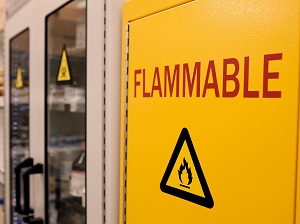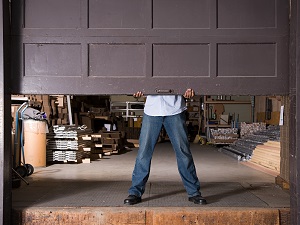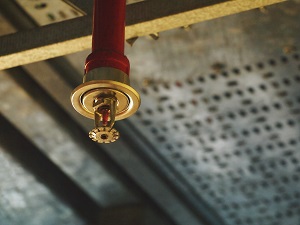Every shop, warehouse, and distribution center is different, which means fire protection at every facility must be tailored specifically to the unique characteristics of the location. Learn more about best practices that can significantly improve fire safety plans in shops and warehouses.

In recent years, more than 1,000 warehouse structure fires have been reported to occur each year in the United States. To properly protect any building and the people that work there, fire protection considerations may include ceiling heights, the types of materials stored or used at that location, and the layout of the facility.
Fire Prevention Plans
The best fire safety plan is to ensure no fires happen at all. However, when fire prevention measures fail, it is just as critical to be prepared to prevent as much damage as possible, extinguish the fire quickly, and evacuate everyone safely.

Storage and Housekeeping
Prevent fires by following proper storage, handling and housekeeping requirements. Good housekeeping is key to fire prevention, but poor housekeeping can lead to small fires that get out of control quickly.
OSHA Standard 1910.176(c) Storage areas shall be kept free from accumulation of materials that constitute hazards from tripping, fire, explosion, or pest harborage.
Never let combustible scrap, rubbish, and waste materials accumulate where they can become fuel for a fire. Store flammable liquids, that are in use, in proper containers that are designed for that use and labeled correctly. Store containers of flammable liquids inside of clearly marked, and properly designed, flammable liquids cabinets.
OSHA Standard 1910.106(e)(9)(iii) Combustible waste material and residues in a building or unit operating area shall be kept to a minimum, stored in covered metal receptacles and disposed of daily.
Oily rags, wipes, or towels that have been used for cleaning off solvents and residue should be stored in covered metal containers to prevent an ignition source. Dispose of combustible wastes and empty all bins at least once a day to avoid a dangerous creation of fire or explosion hazards.

Shops, warehouses, distribution centers, and similar facilities are not always a static environment. The items stored, processes, and products housed may change based on a customer request, production change, or company expansion. For this reason, it is important to review the types of materials stored in the shop or warehouse, on a periodic basis, to ensure that if there were an ignition or fire, then the current fire protection system can handle it.
Plastic products will burn much hotter than other materials, such as concrete or wood, and this can critically affect the type of sprinkler system required for the location. The use of plastic pallets or wooden rack systems should also be considered as part of planning for fire protection.
Consider the following as part of an annual review of the material storage at the facility. For each question, evaluate how any changes could potentially impact the fire prevention and protection plan for the location.
- Have there been any changes to stored materials?
- Has the quantity of materials used or stored changed?
- Has the configuration of the facility, types of racks used, or location of fire safety equipment changed?
- Are the fire extinguishers and sprinkler systems appropriate for the type of materials stored?
- Have new hazardous or flammable materials (like combustible metals, grease, lubricants, or solvents) been added to the facility that may require specialized fire suppression?

Fire Protection
Protecting any facility, like a shop or warehouse, from the dangers of fire also includes ensuring that fire detection systems and fire extinguishing equipment are kept in good, working condition.
Fire extinguishing systems, like sprinklers, must be kept free of obstructions, protected from damage and tested periodically to confirm that they are fully operational in the event of an unexpected fire. These systems may include devices and sensors that detect fire, heat or smoke that activate fire extinguishment or suppression systems.
Never block sprinkler heads, valves, fire hoses, or the system control panels. Always maintain 18-inches between sprinklers and the materials below. Protect any piping against freezing and mechanical damage. Have all required annual inspections, tests, and maintenance performed by professionals.
OSHA Standard 1910.159(c)(10) The employer shall assure that sprinklers are spaced to provide a maximum protection area per sprinkler, a minimum of interference to the discharge pattern by building or structural members or building contents and suitable sensitivity to possible fire hazards. The minimum vertical clearance between sprinklers and material below shall be 18 inches.
Never remove or tamper with any of the seals, inspection tags, or labels attached to fire protection systems. Always report any damage to sprinklers, hoses, pipes, and alarms immediately.

Evacuation Procedures
In the event of a fire, the facility and the occupants must be prepared. The facility must be equipped with fire detection systems to alert workers to the danger and everyone in or near the facility must be prepared to act quickly to protect themselves, their co-workers, and visitors from any potential fire.
OSHA Standard 1910.165(b)(1) The employee alarm system shall provide warning for necessary emergency action as called for in the emergency action plan, or for reaction time for safe escape of employees from the workplace or the immediate work area, or both.
Service and test alarm systems to make sure that workers will be notified quickly to evacuate in the event of a fire. Provide individuals with vision or hearing impairments adequate warning cues, in the event of a fire, by installing alarms with visual and audible signals. Make sure that all workers know what the evacuation alarms and signals sound like, so they recognize the warning.
Mark all exit routes and make sure that they are always kept clear. Never block exits, remove exit signs or cover smoke detectors or sensors. Practice fire drills regularly so that workers understand their responsibilities when a fire emergency takes place. Show new employees the location of emergency exits, exit routes, and any specials procedures as soon as they are brought into the facility.


.jpeg)
